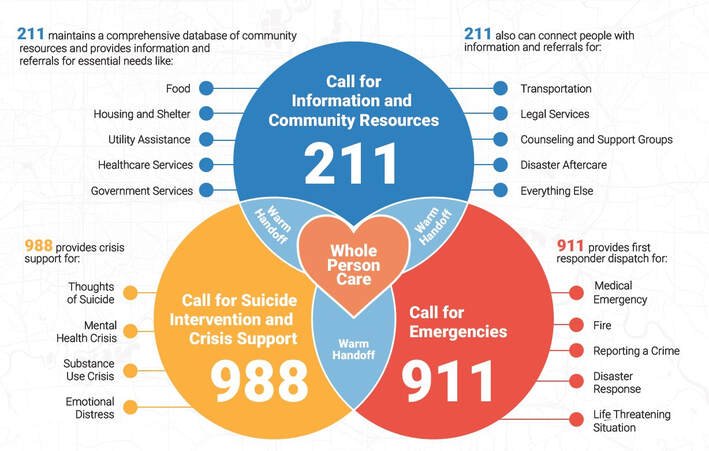
Three-Digit Lifelines: How 911, 988, and 211 Services Create a Safety Net for Every Crisis
These resources are available whether you're seeking help for yourself or someone you're concerned about. The best thing? Of these three options, there is no wrong number to call!
911: Medical Emergencies
Call or Text (Gallatin County)
911 is available for a wide variety of emergencies requiring law enforcement, medical or fire response. Whether it’s a serious medical issue, a car crash, a house fire, or a break-in, calling 911 connects you to the help you need.
In addition, nearly all of Montana’s 56 counties offer text-to-911 services. This option ensures direct access to dispatchers for individuals who are deaf, hard of hearing, or speech impaired. It can also be a lifesaving tool in areas with poor cell service or in situations where making a voice call could put someone in danger, such as during a domestic violence incident.
Our 911 centers are busy and handle a high volume of calls. Please use 911 only for emergencies to ensure dispatchers can assist those in urgent need.
988: Mental Health Crisis & Suicide
Call or Text: 988 or Chat: 988lifeline.org
Veterans & Military: Press 1, Spanish-Speaking: Press 2, LGBTQI+: Press 3
The 988 Suicide & Crisis Lifeline is here for everyone, offering free and confidential emotional support 24/7 across the U.S. Whether you’re struggling with suicidal thoughts, anxiety, or depression, worried about a loved one in crisis, or simply need someone to talk to, help is just a call or text away. Dialing 988 connects you with trained crisis counselors who provide compassionate support, de-escalation techniques, and links to local resources. It’s a lifeline in moments of crisis, offering immediate assistance and connections to additional mental health or emergency services when needed. The support doesn’t stop there—988 can also provide follow-up care to help individuals as they transition to longer-term help.
The 988 Lifeline operates through a network of over 200 local crisis centers, ensuring both national best practices and community-based care. In Montana, three crisis call centers provide 988 services: The Help Center in Bozeman (Southwest region), Voices of Hope in Great Falls (Central & Eastern region), and Lifeline Call Center in Missoula (Northwest region).
211: Community Resource Connection
Call 211 or visit mt211.org
211 serves as a comprehensive information and referral service that helps people navigate the complex web of health and human services. When someone needs help with basic needs like finding food banks, securing affordable housing, accessing mental or physical healthcare, treatment programs, or identifying financial assistance programs, 211 resource specialists can guide them to appropriate local organizations. This is a free, anonymous service available 24/7. No matter where you live in Montana, 211 can connect you to resources.
Additionally, during disasters like floods and wildfires, 211 serves as a critical emergency resource, providing real-time updates about evacuation orders, shelter locations, and resource distribution while reducing burden on emergency systems and allowing emergency responders to focus on life-threatening situations. Additionally, 211 resource specialists can provide emotional support to those impacted and connection to community resources.
211 consists of over 200, 211 agencies in the U.S. The Montana 211 Coalition consists of 5 MT nonprofits: Voices of Hope, Help Center, Missoula 211, Northwestern Montana United Way 211, & United Way of Yellowstone County.
The Gallatin Behavioral Health Coalition (GBHC) provides strategic governance Gallatin County’s multi-agency behavioral health system. The Montana Healthcare Foundation (MHCF) and Montana Department of Public Health and Human Services (DPHHS) fund the GBHC through grants to Gallatin County, which serves as the backbone of the coalition. MHCF and DPHHS fund similar coalitions throughout the state, all of which are working to develop local approaches to providing behavioral health crisis services aligned with the Crisis Now model – someone to call, someone to respond, and somewhere to go.





